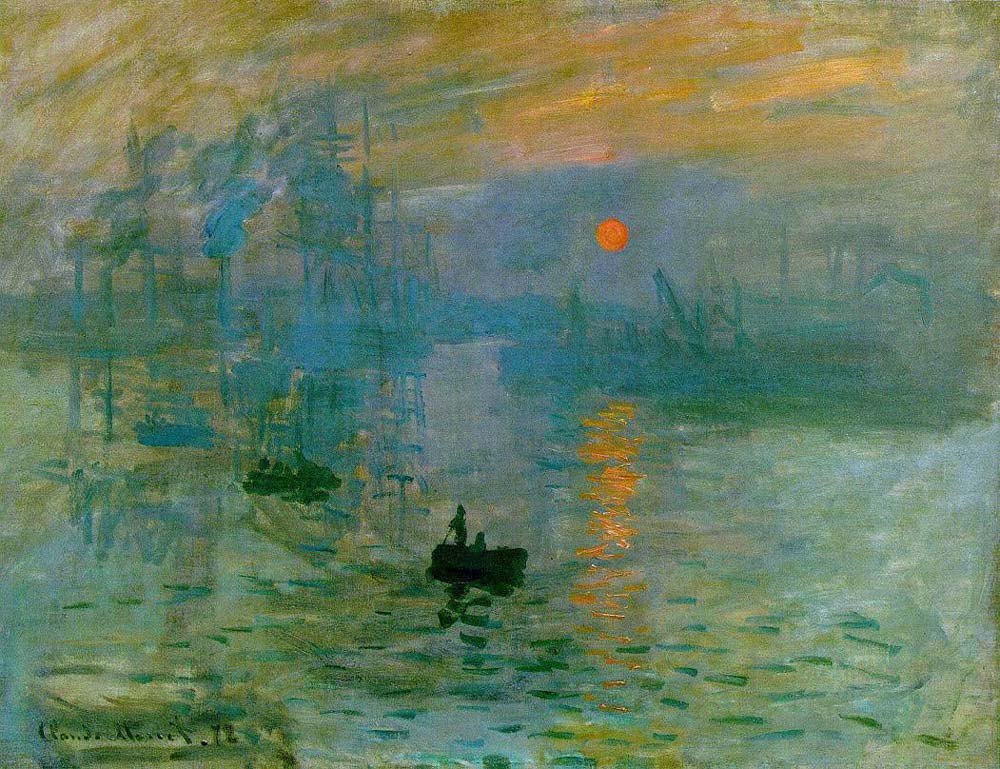| Impression, Sunrise | |
|---|---|
 |
|
| Artist | Claude Monet |
| Year | 1872 |
| Medium | Oil on canvas |
| Location | Musée Marmottan Monet, Paris |
| Dimensions | 18.9 in × 24.8 in |
| 48 cm × 63 cm | |
| Famous Paintings by Claude Monet | |
| Impression, Sunrise | |
| The Magpie | |
| Woman with a Parasol | |
| San Giorgio Maggiore at Dusk | |
| Women in the Garden | |
| Snow at Argenteuil | |
| Beach in Pourville | |
| Bridge over a Pond of Water Lilies | |
| Garden at Sainte-Adresse |
The great French artist, Claude Monet, was responsible for introducing the idea of impression to the art movement of those who painted what they perceived at a certain point in time. Impressionists paint colors perceived with natural light, with little importance given to details. Shapes are formed by how the colors of the scene are detected, forming pictures naturally. Monet originally named the painting Marina, but changed the title to Impression, Sunrise (Impression, Soleil Levant) for the 1874 Exhibition catalog listing. Little did he know, Impression, Sunrise would become the name of a historical art movement.
Conception of the Painting
The scene painted in this Monet painting was of the harbor of LeHavre, in France. It characterizes Monet’s work throughout his lifetime, and is sketched in oil paints on canvas, and executed quickly, to capture the atmospheric or natural light moment. While on vacation, Impression, Sunrise was sketched, while Monet was looking out his window one spring morning. Monet’s quick sketches, or pochade, capture a particular light effect, therefore are very spontaneous. Because Monet did not feel that there was enough detail to title the painting Harbor of LeHavre, the name Impression, Sunrise was given, and Monet titled most of his paintings with “Impression” for this reason.
Description
In this Monet painting, the sun is placed against the dawn sky, with orange and blue-violet contrast. Because it was a very misty morning on the harbor, the clouds are colored by the rising sun, in the dense mist, and the boats take shape, without great definition. The abbreviated, darker brushstrokes in the water, create motion, and ripples, while hints of orange and yellow appear as a reflection of the sunrise in the harbor water. The ships’ masts are sometimes disrupted by the rippling water, as the silhouettes of the boats seem to be disappearing into the mist.
An interesting observation about this painting is that although the sun seems to be much brighter than the rest of the scene, if viewed removing all color, the sun almost disappears. This supports Monet’s mastery of depicting light effects on scenes which he painted. This accurate reproduction of Monet’s impression, and resulting mood of atmospheric conditions dominate, and limit the importance of great detail. The viewer almost feels that he is looking out the same window that Monet did that Spring morning. Once called an abstract piece of unfinished work by critics, over one-hundred years later, Monet’s work Impression, Sunrise is part of a historic art movement, and Monet helped to make a name for the Impressionistic artists as well.